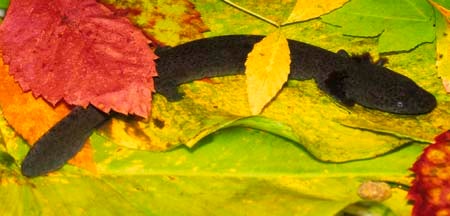SCIENTIFIC NAME:
Necturus alabamensis (Viosca)
OTHER NAMES:
Alabama Water Dog, West Sipsey Fork Waterdog, Mudpuppy
STATUS:
Threatened. Restricted to upper Black Warrior River Basin in Southwestern Appalachians. Occurs only in Alabama. Surveys of 59 potential streams in the 1990s yielded this species at only 14 of 113 sites. Status at reservoirs unknown. Susceptible to water quality degredation. Currently a candidate for federal listing. HIGHEST CONSERVATION CONCERN.
DESCRIPTION:
A large (max. recorded total length = 248 mm [9.8 in]) (Bart et al. 1997), gilled, aquatic salamander. Adults somewhat variable in color. Enlarged dark spots on each side larger than spots on dorsum or venter, usually forming a single dorsolateral row or stripe that is generally contiguous with the dark stripe on side of head and with a broad band of dark pigment on tail. Underside of legs and toes white. Ventral surface white along midline with varying degrees of dark spotting. The largest recorded specimen, from Mulberry Fork, is very dark purple-black with no spotting. Unclear whether this melanistic pattern is an aberration, or related to large size and presumed old age (Bart et al. 1997). Post-hatchling juveniles exhibit a distinctive color pattern. Dorsum and sides have broad dark chocolate brown stripes separated by two distinct cream to yellow stripes beginning at the nostrils and extending to the tail. At the post-hatchling and juvenile stages, nearly indistinguishable from the mudpuppy of the Tennessee drainage. For decades subsequent to the description of N. alabamensis (Viosca 1937), the scientific name was erroneously applied to the more common, widespread, and predominantly Coastal Plain Necturus species that occurs sympatrically with N. alabamensis at, and just above, the Fall Line. This usage continued until Bart et al. (1997) clarified the taxonomy. The more common species presently lacks a scientific name, and is referred to as N. sp. cf. beyeri. (Bart et al. 1997, Bailey and Moler 2003).
DISTRIBUTION:
Limited to streams above the Fall Line within the BlackWarriorRiver Basin in Alabama. Presently known from 14 scattered locations in the Black Warrior River, North River, Locust Fork, Mulberry Fork, and Sipsey Fork drainages and their tributaries in Blount, Tuscaloosa, Walker, and WinstonCounties (Ashton and Peavy 1986, Bart et al. 1997, Durflinger et al. 2001). Likely occurs in suitable stream habitat throughout the Upper Black Warrior River drainage, with a distribution similar to that of the flattened musk turtle.
HABITAT:
Moderate to large streams with moderate flows and alternating pools and rapids. Rocks and other cover are generally present and probably play an important role in determining habitat suitability. Semi-permanent leaf packs thought to be important, especially to post-hatchlings and juveniles. When comparing sites with Black Warrior waterdogs with sites from which they were absent, the species was associated with stream depths of one to four meters [3.3 to 13.1 feet], reduced sedimentation, and large leaf packs supporting ephemeropteran and trichopteran larvae (Durflinger et al. 2001).
LIFE HISTORY AND ECOLOGY:
Nocturnal. Can be located most frequently in submerged accumulations of leaf litter at bottom of streams from early November through early March. Nests unknown, but post-hatchling larvae have been collected in December, suggesting late spring or early summer nesting (Ashton and Peavy 1986). Although diet unknown, studies of other Necturus species suggest they feed on small fishes, fish eggs, amphipods, tadpoles, larval salamanders, crayfish, annelids, and aquatic insect larvae. Specific predators unknown, although predatory fishes, water snakes, herons, and river otters consume other species of Necturus.
BASIS FOR STATUS CLASSIFICATION:
A highly restricted geographic distribution, unpredictable occurrence within this distribution, and apparent low population densities at even the best localities all contribute to species’ precarious conservation status. Populations likely at risk of extirpation due to increased sedimentation and pollution levels resulting from mining, forestry, agricultural activities (especially poultry farms and cattle feedlots), and industrial and residential sewage effluent. Species of fishes, mussels, and snails (Mettee et al.1989, Hartfield 1990), and populations of the flattened musk turtle (U.S. Fish and Wildlife Service 1990), have been extirpated from large areas of the watershed due primarily to water quality degradation. A subjective assessment of habitat at 11 historic localities (Bailey 2000) concluded that two (18 percent) of the sites were good to excellent in quality, three (27 percent) were moderate, two (18 percent) were poor to unsuitable, and four (36 percent) were in impoundments. Artificial impoundments constructed within the BlackWarriorBasin have altered much former habitat. With restricted flow, limited shallow water, and abundant predatory game fish, such reservoirs are likely marginal or unsuitable habitat for this salamander, but its status in large impoundments such as Smith Lake and Bankhead Lake remains to be adequately assessed. Presently a candidate for federal listing as threatened or endangered (U.S. Fish and Wildlife Service 1999).
Authors: Mark A. Bailey and Craig Guyer






